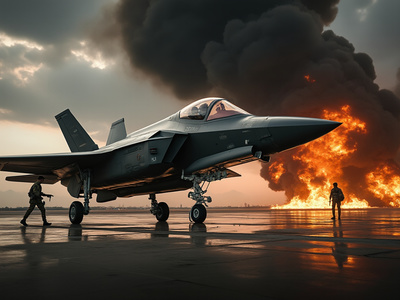
Syria Welcomes Lifting of US Sanctions Amid Major Saudi-US Defense Deal
Trump announces cessation of sanctions on Syria, while Saudi Arabia commits to a historic $142 billion defense sales agreement.
In a significant shift in US foreign policy, President Donald Trump announced the lifting of sanctions against Syria, referring to it as an opportunity for the country to begin its reconstruction.
In remarks made at an investment forum in Riyadh, Trump stated, "I will be ordering the cessation of sanctions against Syria in order to give them a chance at greatness." This development has been received positively by the Syrian government, with Foreign Minister Asaad Shibani expressing gratitude to Saudi Arabia for facilitating this change, labeling it a "new start" for Syria.
The sanctions, originally imposed to discourage the government of Bashar al-Assad from violent repression during the Syrian civil war, have become a point of contention as the country seeks to rebuild.
Analysts and activists in Syria expressed cautious optimism about the potential economic recovery.
In related developments, the United States and Saudi Arabia finalized a historic arms deal valued at $142 billion, which the White House has called the "largest defense sales agreement in history." This deal is viewed as part of Trump’s broader intention to boost American interests through direct economic ties.
As part of his tour in the Gulf region, the president also mentioned the potential for future investments that could total up to $1 trillion, building relationships with major US tech firms.
Trump's announcement to lift sanctions coincided with an informal meeting scheduled with Syria's new leader, Ahmed al-Sharaa, marking the first face-to-face dialogue between a US president and a Syrian leader since 2000. The anticipated meeting aims to explore avenues for normalization of relations and economic partnerships, amid proposed offers from Sharaa, including access to Syrian oil fields and reconstruction contracts.
Reports suggest that Sharaa's government is interested in establishing various business ventures, including a Trump Tower in Damascus.
During his address, Trump also addressed ongoing tensions with Iran, labeling it the "most destructive force" in the Middle East.
He emphasized the necessity for Iran to accept a nuclear deal or face increased pressure from the United States.
Trump's nuanced approach indicates a shift from traditional diplomatic stances towards transactional agreements that prioritize American economic gains.
The meetings and agreements outlined during Trump’s Gulf visit reflect a broader strategy of reorienting US foreign policy towards pragmatic partnerships, with significant implications for Middle Eastern stability and US international relations.
While some view these moves as a pragmatic recalibration, others have voiced concerns regarding potential conflicts of interest, particularly given Trump’s business ties in the region.
The geopolitical landscape continues to evolve, with Trump's insistence that Saudi Arabia’s recognition of Israel would be pursued, albeit at its own timeline and conditions influenced by the ongoing conflict in Gaza.
This evolving narrative also signals an intricate balancing act faced by the Trump administration in navigating relations with longstanding allies and addressing emerging regional dynamics.
In remarks made at an investment forum in Riyadh, Trump stated, "I will be ordering the cessation of sanctions against Syria in order to give them a chance at greatness." This development has been received positively by the Syrian government, with Foreign Minister Asaad Shibani expressing gratitude to Saudi Arabia for facilitating this change, labeling it a "new start" for Syria.
The sanctions, originally imposed to discourage the government of Bashar al-Assad from violent repression during the Syrian civil war, have become a point of contention as the country seeks to rebuild.
Analysts and activists in Syria expressed cautious optimism about the potential economic recovery.
In related developments, the United States and Saudi Arabia finalized a historic arms deal valued at $142 billion, which the White House has called the "largest defense sales agreement in history." This deal is viewed as part of Trump’s broader intention to boost American interests through direct economic ties.
As part of his tour in the Gulf region, the president also mentioned the potential for future investments that could total up to $1 trillion, building relationships with major US tech firms.
Trump's announcement to lift sanctions coincided with an informal meeting scheduled with Syria's new leader, Ahmed al-Sharaa, marking the first face-to-face dialogue between a US president and a Syrian leader since 2000. The anticipated meeting aims to explore avenues for normalization of relations and economic partnerships, amid proposed offers from Sharaa, including access to Syrian oil fields and reconstruction contracts.
Reports suggest that Sharaa's government is interested in establishing various business ventures, including a Trump Tower in Damascus.
During his address, Trump also addressed ongoing tensions with Iran, labeling it the "most destructive force" in the Middle East.
He emphasized the necessity for Iran to accept a nuclear deal or face increased pressure from the United States.
Trump's nuanced approach indicates a shift from traditional diplomatic stances towards transactional agreements that prioritize American economic gains.
The meetings and agreements outlined during Trump’s Gulf visit reflect a broader strategy of reorienting US foreign policy towards pragmatic partnerships, with significant implications for Middle Eastern stability and US international relations.
While some view these moves as a pragmatic recalibration, others have voiced concerns regarding potential conflicts of interest, particularly given Trump’s business ties in the region.
The geopolitical landscape continues to evolve, with Trump's insistence that Saudi Arabia’s recognition of Israel would be pursued, albeit at its own timeline and conditions influenced by the ongoing conflict in Gaza.
This evolving narrative also signals an intricate balancing act faced by the Trump administration in navigating relations with longstanding allies and addressing emerging regional dynamics.









